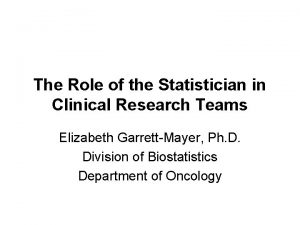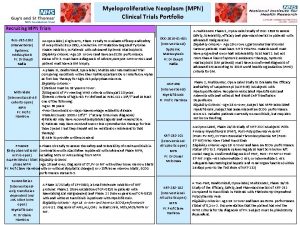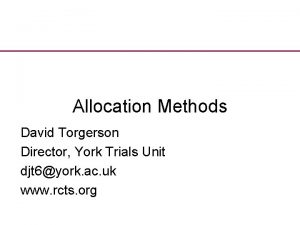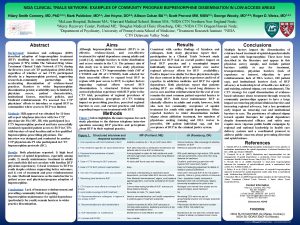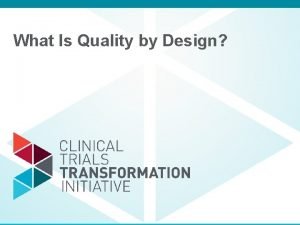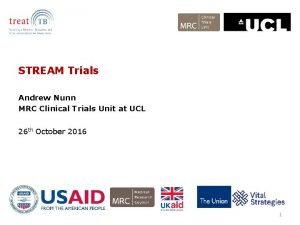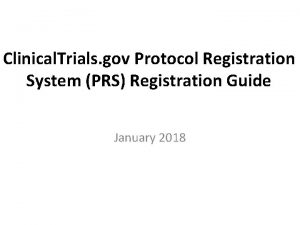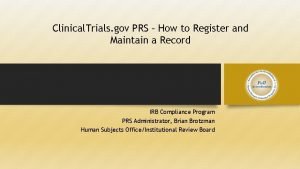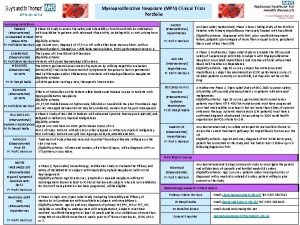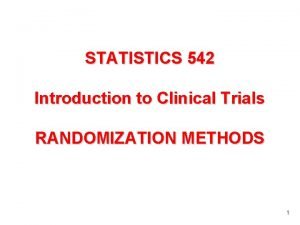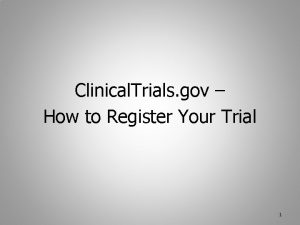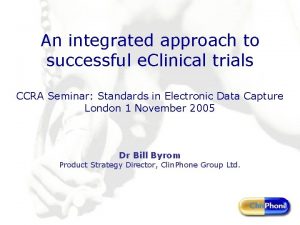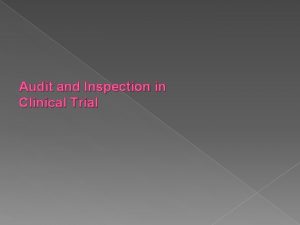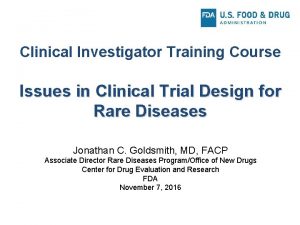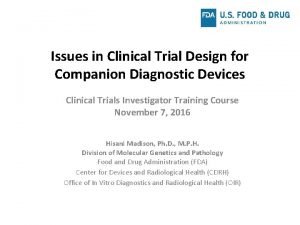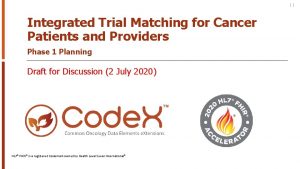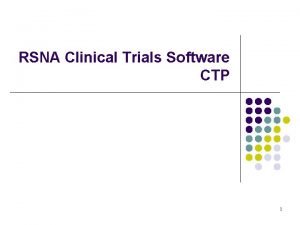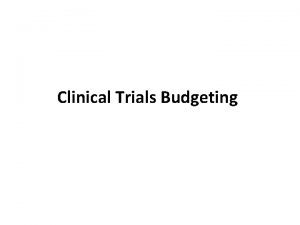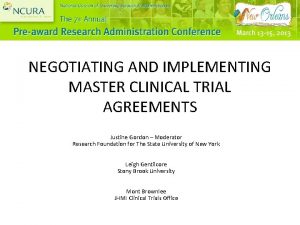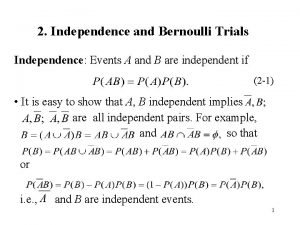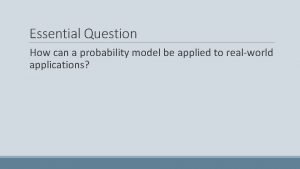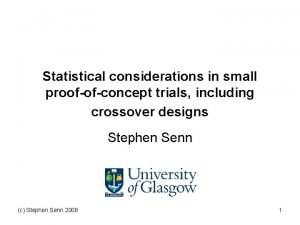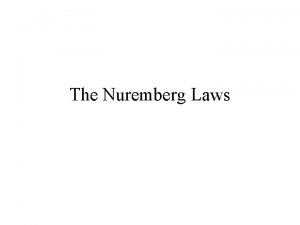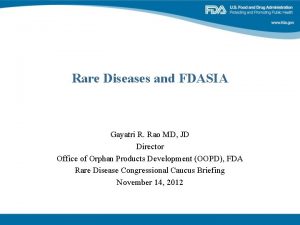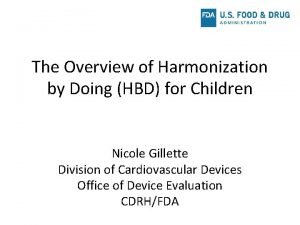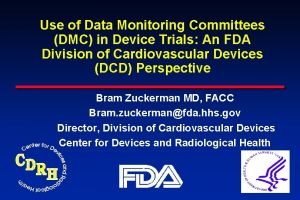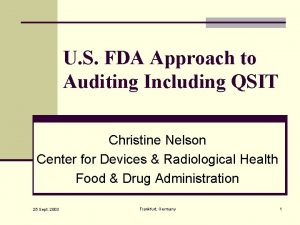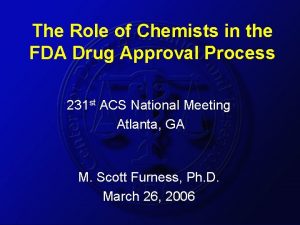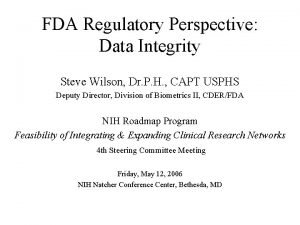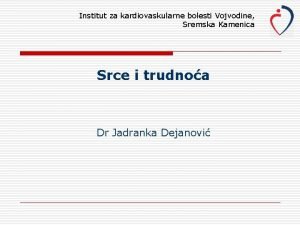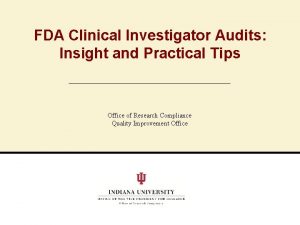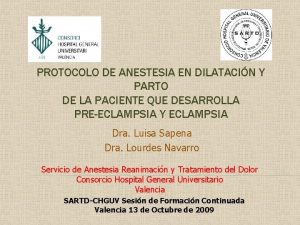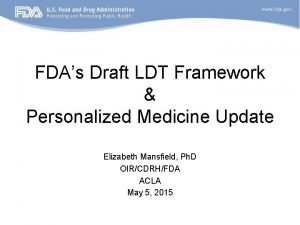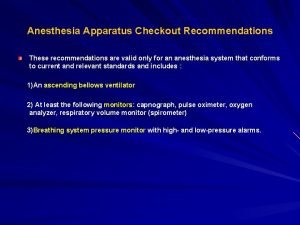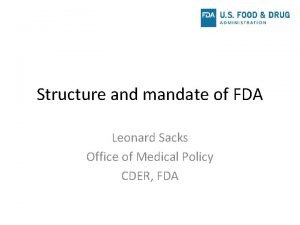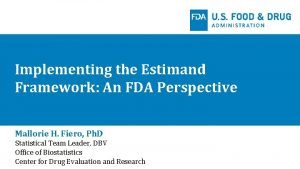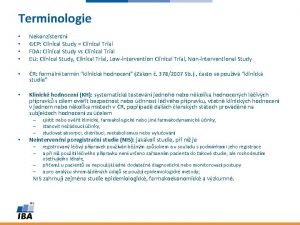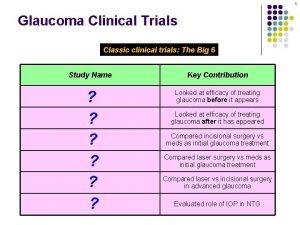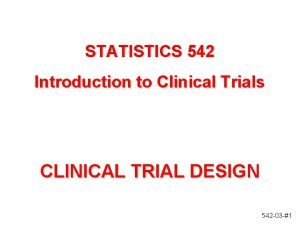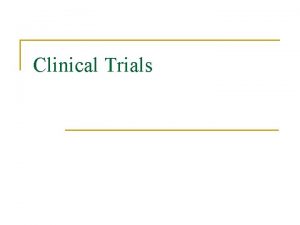What are clinical trials FDA A clinical trial














































![Relationship Among Non-inferiority, Superiority, and Equivalence µs-d [ |¬ µs | µs+d ] Equivalence Relationship Among Non-inferiority, Superiority, and Equivalence µs-d [ |¬ µs | µs+d ] Equivalence](https://slidetodoc.com/presentation_image_h/d48dca7fc42c1b2062eccda3de13f224/image-47.jpg)
![Relationship Among Non-inferiority, Superiority, and Equivalence µs-d [ Inferiority®|¬ µs µs+d | ] Non-inferiority Relationship Among Non-inferiority, Superiority, and Equivalence µs-d [ Inferiority®|¬ µs µs+d | ] Non-inferiority](https://slidetodoc.com/presentation_image_h/d48dca7fc42c1b2062eccda3de13f224/image-48.jpg)
![Relationship Among Non-inferiority, Superiority, and Equivalence µs-d [ µs | µs+d ] Non-superiority ®|¬ Relationship Among Non-inferiority, Superiority, and Equivalence µs-d [ µs | µs+d ] Non-superiority ®|¬](https://slidetodoc.com/presentation_image_h/d48dca7fc42c1b2062eccda3de13f224/image-49.jpg)























































- Slides: 104



What are clinical trials? • FDA – A clinical trial is the clinical investigation of a drug which is administered or dispensed to, or used involving one or more human subjects. • 台灣行政院衛生署 – 藥品施用於病人或健康自願者身上,已發現或 驗證其療效,認明其不良反應、研究該藥品在 人體的吸收、分布、代謝和排泄過程,以確定 其有效性和安全性的系統性研究。













ICH 制定規範 • Q: “Quality” – Chemical and Pharmaceutical Quality Assurance • 安定性試驗 • S: “Safety” – In vitro and in vivo pre-clinical studies • E: “Efficacy” – Clinical studies in human subject • E 6 – GCP • E 8 – General considerations for clinical trials • E 9 – Statistical principles for clinical trials • M: “Multidisciplinary” – Not fit uniquely into one of the above categories




Paper CRF、e-CRF

Basic Principle on Clinical Trial Design • Objective – To obtain an unbiased and reliable assessment of given regimen response, independent of any known or unknown prognostic factors. • Principle Allocation at random Representative Blinding Reliability Control group Reproducibility

Allocation at Random • Tends to produce treatment groups in which the distributions of prognostic factors are similar – Stratification • If there are known factors that could affect the outcome (center, age, sex, baseline risk) • Only one or few factors used for stratification – Block • Block size divisible by number of treatment • Block size of two is not used

Simpson’s Paradox Overall Group 1 (Male) Group 2 (Female) Success Yes Regimen A 289 (83%) Regimen B 273 (78%) No 61 (17%) 77 (22%) Yes 234 (83%) 81 (93%) No 36 (17%) 6 (7%) Yes 55 (69%) 192 (73%) No 25 (31%) 71 (27%)

Permuted-Block Randomization • Random Allocation within each block – 1, 2, 3, 4 • By Random Selection of Blocks – – – TTPP PPTT TPTP TPPT PTTP

Blinding • To limit the occurrence of conscious and unconscious bias in the conduct and interpretation of a clinical trial – Open – Single Blind – Double Blind • To maintain the blind a control must look, smell, taste and feel the same as the comparator of interest, whether the treatment is a placebo or an active control – maybe with double dummy.

Double Dummy • Occasions – No matching placebo available – Different frequencies • Example

Control Groups • Placebo control • U. S. FDA (most desirable) • Other countries (less acceptable) • Unethical (sometime) • Active comparator control • Established, standard treatment used for the condition • Three treatment group (placebo & active) • Historical control • Cancer trial • No control (observational study)

Representative • The primary variable (“target” variable, primary endpoint) should be the variable capable of providing the most clinically relevant and convincing evidence directly related to the primary objective of the trial. – ICH E 9

Reliability • If any of the efficacy or safety assessments was not standard, i. e. , widely used and generally recognized are reliable, accurate and relevant (able to discriminate between effective and ineffective agents), its reliability, accuracy and relevance should be documented. It may be helpful to describe alternatives considered but rejected. – ICH E 3

Reproducibility • If the outcome is to be recorded on different sessions then one should know the repeatability of the measure so one can appropriately quantify any longitudinal treatment effect.

Three Key Components • Experimental unit – A subject from a targeted population under study • Treatment – It could be a placebo or any combinations of (pharmaceutical entity, diet, surgical procedure, diagnostic test, medical device, no treatment) • Evaluation – Efficacy analysis (Clinical endpoints) – Safety assessment (Adverse experience, Laboratory test results) – Others (Quality of life assessment, Pharmacoeconomics and outcomes research)

Adequate and Well-controlled Study • • Objective (clear) Methods of analysis (appropriate statistical methods) Design (valid for addressing scientific questions) Selection of subjects (assurance of the disease under study) Assignment of subjects (minimize bias) Participants of studies (minimize bias) Assessment of responses (well-defined and reliable) Assessment of the effect (accurate and reliable)

Key Statistical Concepts • • • Bias and Variability Hypothesis Testing Type I Error and Power Confounding and Interaction Statistical Difference vs Clinical Difference Sample Size


Bias • An inclination or preference that interferes with impartial judgment (Webster’s Dictionary, 1984) • A systematic error that enters a clinical trial and distorted the data obtained as opposed to a random error (Spilker, 1991) • It measures the closeness of the test result to the true value (e. g. , population mean) • Accuracy

Variability • A measure of precision or reliability that is referred to as the degree of closeness of clinical results to the true value regarding the targeted patient population • The higher precision, the more likely the result can be reproduced • Precision

Bias and Variability Less bias, small variability Large bias, small variability Less bias, large variability Large bias, large variability

Bias and Variability • It is not possible to avoid bias and variability in real world. • It is important to – identify, – eliminate, and – control the bias/variability to an acceptable limit.

Step on Performing Hypotheses Testing • Choose the null hypothesis that is to be questioned. • Choose an alternative hypothesis that is of particular interest to the investigators. • Select a test statistic, and define the rejection region (or a rule) for decision making about when to reject the null hypothesis and when not to reject it. • Draw a random sample by conducting a clinical trial. • Calculate the test statistic and its corresponding pvalue. • Make conclusion according to the predetermined rule.

Type of Hypotheses Testing • Test for Equivalence • Test for Non-inferiority • Test for Superiority – Clinical – Statistical

Test for Equivalence • Purpose – To show that the test drug can reach the same therapeutic effect as that of a standard therapy (or an active agent) or they are therapeutically equivalent

Test for Equivalence • Hypothesis – Null hypothesis: There is a clinically meaningful difference between the test drug and the standard therapy – Alternative hypothesis: There is no clinically meaningful difference between the test drug and the standard therapy • The rejection of the null hypothesis suggests that there is no clinically meaningful difference between the test drug and the standard therapy and hence we conclude that the test drug is equivalent to the standard therapy.

Test for Non-inferiority • Purpose – To show that the test drug is no worse than a standard therapy or an active agent • Situations where it is applicable – The test drug is less toxic – The test drug is easier to administer – The test drug is less expensive

Test for Non-inferiority • Hypothesis – Null hypothesis: The test drug is inferior to the standard therapy – Alternative hypothesis: The test drug is not inferior to the standard therapy • The concept is to reject the null hypothesis and conclude that the difference between the test drug and the standard therapy is less than a clinically meaningful difference and hence the test drug is no worse than the standard therapy.

Test for Superiority • Purpose – To show that the test drug is superior to a standard therapy or an active agent

Test for Superiority • Hypothesis (Statistically -> Clinically) – Null hypothesis: There is no clinically meaningful difference between the test drug and the standard therapy – Alternative hypothesis: The test drug is superior to the standard therapy • The rejection of the null hypothesis suggests that the difference between the test drug and the standard therapy is greater than a clinically meaningful difference and hence we conclude that the test drug is superior to the standard therapy.
![Relationship Among Noninferiority Superiority and Equivalence µsd µs µsd Equivalence Relationship Among Non-inferiority, Superiority, and Equivalence µs-d [ |¬ µs | µs+d ] Equivalence](https://slidetodoc.com/presentation_image_h/d48dca7fc42c1b2062eccda3de13f224/image-47.jpg)
Relationship Among Non-inferiority, Superiority, and Equivalence µs-d [ |¬ µs | µs+d ] Equivalence ®| There is no clinically significantly meaningful difference between the test drug and the standard therapy. It is usually referred to as two-sided equivalence.
![Relationship Among Noninferiority Superiority and Equivalence µsd Inferiority µs µsd Noninferiority Relationship Among Non-inferiority, Superiority, and Equivalence µs-d [ Inferiority®|¬ µs µs+d | ] Non-inferiority](https://slidetodoc.com/presentation_image_h/d48dca7fc42c1b2062eccda3de13f224/image-48.jpg)
Relationship Among Non-inferiority, Superiority, and Equivalence µs-d [ Inferiority®|¬ µs µs+d | ] Non-inferiority = at least as effective as … It is also referred to as one-sided equivalence
![Relationship Among Noninferiority Superiority and Equivalence µsd µs µsd Nonsuperiority Relationship Among Non-inferiority, Superiority, and Equivalence µs-d [ µs | µs+d ] Non-superiority ®|¬](https://slidetodoc.com/presentation_image_h/d48dca7fc42c1b2062eccda3de13f224/image-49.jpg)
Relationship Among Non-inferiority, Superiority, and Equivalence µs-d [ µs | µs+d ] Non-superiority ®|¬ Superiority Non-superiority = at most as effective as … It is also referred to as one-sided equivalence

Relationship Among Non-inferiority, Superiority, and Equivalence µs-d [ Inferiority ®|¬ |¬ µs | Equivalence µs+d ] ®|¬ Superiority Non-inferiority Non-superiority ®| One-sided Equivalence

Relationship Among Non-inferiority, Superiority, and Equivalence µs-d [ Inferiority ®|¬ H 0: µT-µs £ -d Ha: µT-µs > -d µs | Equivalence H 0: |µT-µs| ³ d Ha: |µT-µs| < d µs+d ] ®|¬ Superiority H 0: µT-µs £ d Ha: µT-µs > d Would like to reject the null hypothesis and conclude the alternative hypothesis

Relationship Among Non-inferiority, Superiority, and Equivalence

Equivalence Margin

Type I Error and Power Null hypothesis: The drug is ineffective Alternative hypothesis: The drug is effective Type I error : the drug works when in fact it doesn’t. Type II error : the drug doesn’t work when in fact it does. P-value : the probability of observing a type I error. Power : the probability of correctly concluding that the drug works when in fact it does.

Type I Error and Power

Type I Error and Power • Decrease type I error will result in increasing type II error, and consequently decreasing power. • Increase sample size will decrease both type I and type II errors. • Fixed type I error and select a sample size to achieve the desired power.

Confounding and Interaction • Confounding – Confounding effects are defined as effects which are contributed by various factors that cannot be separated by the design under study. • Interaction – The interaction effect between factors is defined as the joint effect contributed by more than one factor.

Confounding • Lab Example – Dr. Anderson noticed that recent laboratory test results failed to pass QC/QA requirements – Dr. Anderson decided to improve the laboratory procedure by purchasing a more advanced equipment – The accuracy and precision of the laboratory test results improve significantly and meet the QC/QA • Question – It is not clear whether the improvement in laboratory test results is due to the advanced new equipment or due to the analyst who has more experience than the previous analyst.

Interaction • Quantitative interaction between treatment and center (or study site) indicates that the treatment differences are in the same direction across centers but the magnitude differs from center to center. • Qualitative interaction Substantial treatment differences occur in different directions in different centers.

Center-by-Treatment Interaction Treatment Control Center 1 Center 2 Quantitative interaction - centers could be combined.

Center-by-Treatment Interaction Drug A Drug B Center 1 Drug A Center 2 Qualitative interaction - centers cannot be combined.

Confounding and Interaction • Study design should avoid or be able to account for potential – Confounding factors – Interaction factors • Objectives – To provide a valid and fair assessment of the treatment effect – To assess the treatment difference efficiently

Impact on Center Imbalance • Coefficient of Imbalance (λ) – Drug Information Journal. Vol. 38 pp. 387 -394, 2004 At α=0. 05 1 Power (90%) 90% Power (80%) 80% 0. 5 Power (90%) 63% Power (80%) 50% 0. 9 86% 75% 0. 4 53% 42% 0. 8 82% 70% 0. 3 42% 33% 0. 7 77% 64% 0. 2 30% 23% 0. 6 70% 58% 0. 1 17% 14% λ λ

Example of Center Imbalance Source Sample No. of Size Country 1 -α/2 1 -β λ Adjuste d Power Trial I 885 29 0. 95 0. 8 0. 90739 0. 761 Trial II 143 9 0. 95 0. 8 0. 45696 0. 474 Trial III 518 25 0. 95 0. 86231 0. 739

No. of Centers and Size of Center • Balance in each center • Number of patients in each centers – The number of patients in each center should not be less than the number of centers

Statistical Difference vs. Scientific Difference • Clinical Scientists & Researchers – The observed difference is of clinical meaning and yet not statistically significance (You must be out of your mind!) – The observed difference is of little clinical meaning but it is statistically significant (Who cares? ) • Statisticians – P-value must be less than 0. 05 in order to have statistical meaning

Statistical Difference vs. Scientific Difference • Statistical difference – A difference which is unlikely to occur by chance alone. • Clinical/Scientific difference – A difference which is considered important to the clinical scientists.

Statistical Difference vs. Scientific Difference Statistical difference Clinical difference * May be due to large variability and/or small sample size

Sample Size Determination Information Required • Study objectives – Test for equivalence – Test for non-inferiority – Test for superiority (clinically/statistically) • Study design – Parallel or crossover – Group sequential design – Other designs • Primary study endpoint(s) – Continuous or discrete – Multiple study endpoints

Sample Size Determination Information Required • Clinically meaningful difference – Clinically important difference – Non-inferiority/superiority margin – Equivalence/similarity limit • Significance level – 1% or 5% • Desired power – 80% or 90% • Other information, e. g. , – Stratification? – 1: 1 ratio or 2: 1 ratio? – Log-transformation?

Parallel Design – Equivalence Hypotheses • • • : Population mean of the treatment : Population mean of the control : Equivalence limit.

Parallel Design – Equivalence Two one-sided test procedure (Schuirmann, 1987) • Test statistics • Reject the null hypothesis if

Parallel Design – Equivalence Power

Parallel Design – Equivalence Sample size calculation

Classification of Statistical Tests • Category – Treatment • Chi-square (PROC FREQ) • Fisher’s exact test (PROC FREQ) – Treatment + Others • CMH with table score (PROC FREQ) • CMH with rank score (PROC FREQ) • Logistic Regression (PROC LOGISTIC/ PROC CATMOD)

Classification of Statistical Tests • Quantitative – Treatment • Unpaired t test (PROC TTEST) • Wilcoxon rank-sum test (PROC NPAR 1 WAY) – Treatment + Others • GLM (PROC GLM) • GLM with rank-transformed (PROC RANK + PROC GLM)

Classification of Statistical Tests • Survival – Chi-square (PROC LIFEREG) – Log-rank test (PROC LIFETEST) – Cox proportional hazards model (PROC PHREG)

The t test

The t test

The t test

Example • A treatment is being examined to determine its effect on systolic blood pressure. • Twelve men participate in the study. • Their systolic blood pressure is measured both before and after the treatment is applied.

Results

Result

Result

Result

ANCOVA • Analysis of covariance combines some of the features of both regression and analysis of variance. Typically, a continuous variable (the covariate) is introduced into the model of an analysis-of-variance experiment. Example • Ten patients are selected for each treatment (Drug A or D), and six sites on each patient are measured for leprosy bacilli. • The covariate (a pretreatment score) is included in the model for increased precision in determining the effect of drug treatments on the posttreatment count of bacilli.

Result

Result

Analysis Population • Intent To Treat (ITT) Set • Full Analysis Set • Per Protocol Set (PP)

Superiority • In superiority trials the full analysis set is used in the primary analysis because it tends to avoid over-optimistic estimates of efficacy resulting from a per protocol analysis, since the non-compliers included in the full analysis set will generally diminish the estimated treatment effect.

Equivalence/Non-inferiority • In an equivalence or non-inferiority trial use of the full analysis set is generally not conservative and its role should be considered very carefully. • Subjects who withdraw or dropout of the treatment group or the comparator group will tend to have a lack of response, and hence the results of using the full analysis set may be biased toward demonstrating equivalence.


SAS Output Delivery System

What Is the Output Delivery System? • Prior to Version 7, SAS procedures that produced printed output generated output that was designed for a traditional line-printer. • Beginning with Version 7, procedure output became much more flexible. The Output Delivery System (ODS) has been designed to overcome the limitations of traditional SAS output and to make it easy to make new formatting options available to users. • ODS is a method of delivering output in a variety of formats and of making the formatted output easy to access.

Basic Concepts of the ODS • In the past, the term "output" has generally referred to the outcome of a SAS procedure step. You could send this output to the Output window if you were working in a windowing environment, to an output device if you were working in line mode, or to a file if you used PROC PRINTTO or SAS system options.

ODS Destinations • ODS currently supports four destinations: – The Listing destination produces monospace output, which is formatted like traditional SAS procedure output. (ODS LISTING) – The HTML destination produces output that is formatted in Hypertext Markup Language. (ODS HTML) – The Printer destination produces output that is formatted for high-resolution printers. (ODS PRINTER) – The Output destination produces SAS data sets. (ODS OUTPUT)

Example – t test PROC TTEST DATA=AH 01; VAR LABVALUE CHANGE; BY VISIT; RUN;

Output

ODS TRACE ON; PROC TTEST DATA=AH 01; VAR LABVALUE CHANGE; BY VISIT; RUN; ODS TRACE OFF;

LOG Output Added: ------Name: Statistics Label: Statistics Template: Stat. TTest. Statistics Path: Ttest. By. Group 1. Statistics ------Output Added: ------Name: TTests Label: T-Tests Template: Stat. TTests Path: Ttest. By. Group 1. TTests -------

Program ODS LISTING CLOSE; ODS OUTPUT STATISTICS=AS TTESTS=AT; PROC TTEST DATA=AH 01; VAR LABVALUE CHANGE; BY VISIT; RUN; ODS LISTING;

Contents (AS)

Contents (AT)

http: //v 8 doc. sas. com/sashtml/
 Antigentest åre
Antigentest åre Clinical research statistician
Clinical research statistician Readyset ohsu
Readyset ohsu Mpn clinical trials
Mpn clinical trials York trials unit
York trials unit Nida clinical trials network
Nida clinical trials network Clinical trials quality by design
Clinical trials quality by design Mrc clinical trials unit
Mrc clinical trials unit Prs clinical trials
Prs clinical trials Prs registration
Prs registration Site initiation visit powerpoint presentation
Site initiation visit powerpoint presentation Mpn clinical trials
Mpn clinical trials Stratified randomization
Stratified randomization Clinical trials.gov login
Clinical trials.gov login Clinical trials
Clinical trials Clinicaltrials gov api
Clinicaltrials gov api Clinical hysteria salem witch trials
Clinical hysteria salem witch trials Dhl bishkek
Dhl bishkek Phs human subjects and clinical trials information
Phs human subjects and clinical trials information Pharmaceutical iwr applications
Pharmaceutical iwr applications Difference between inspection and audit
Difference between inspection and audit Clinical investigator training program
Clinical investigator training program Fda disqualified list
Fda disqualified list Fsfd clinical trial
Fsfd clinical trial Accelerated clinical trial agreement acta
Accelerated clinical trial agreement acta Novel clinical drug trial design
Novel clinical drug trial design Ivd clinical trial design
Ivd clinical trial design Clinical trial matching service
Clinical trial matching service Ctp dicom
Ctp dicom Mosaico clinical trial
Mosaico clinical trial Clinical trial exports
Clinical trial exports Clinical trial financial management
Clinical trial financial management Ui division of sponsored programs
Ui division of sponsored programs Morpheus clinical trial
Morpheus clinical trial Clinical trial centers alliance
Clinical trial centers alliance Clinical trial worksheet
Clinical trial worksheet Clinical trial timeline
Clinical trial timeline Trofinetide
Trofinetide Clinical trial budget example
Clinical trial budget example Master clinical trial agreement
Master clinical trial agreement Ndsu corn variety trials
Ndsu corn variety trials 6 trials of jesus
6 trials of jesus Repeated bernoulli trials
Repeated bernoulli trials Hercules supernatural aid
Hercules supernatural aid How is the crucible unlike the salem witch trials?
How is the crucible unlike the salem witch trials? Random control trials
Random control trials Do these situations involve bernoulli trials
Do these situations involve bernoulli trials National geographic salem witch trials
National geographic salem witch trials Design and analysis of cross-over trials
Design and analysis of cross-over trials Overcoming trials and temptations
Overcoming trials and temptations Pediatric trials network
Pediatric trials network Rebecca nurse salem witch trials
Rebecca nurse salem witch trials Salem witch trials facts
Salem witch trials facts Korean bridging trials
Korean bridging trials Malta football trials
Malta football trials Future search trials
Future search trials Benjamin spock apush
Benjamin spock apush Japanese bridging trials
Japanese bridging trials Nordic field trial system
Nordic field trial system 011335577
011335577 Virtual field trip salem witch trials
Virtual field trip salem witch trials Dbq salem witch trials
Dbq salem witch trials Bernoulli trials formula
Bernoulli trials formula Nuremberg trials
Nuremberg trials Many kids called unfit for adult trials
Many kids called unfit for adult trials Ccea
Ccea Salem witch trials discovery education
Salem witch trials discovery education Neumedix
Neumedix Gayatri rao fda
Gayatri rao fda Fda organizational chart
Fda organizational chart Recall coordinator
Recall coordinator 513g
513g Fda early feasibility study
Fda early feasibility study Fda ora org chart
Fda ora org chart Fda cgmp training
Fda cgmp training Fda cosmetic labeling guide
Fda cosmetic labeling guide Nicole gillette fda
Nicole gillette fda Fda approval means nothing
Fda approval means nothing Fda dmc guidance
Fda dmc guidance Fda qsit
Fda qsit Fda technical assistance network
Fda technical assistance network Iso tr 24971
Iso tr 24971 Bonnie hill
Bonnie hill Fda chemist
Fda chemist What part of gcp mandates data integrity
What part of gcp mandates data integrity Fda klasifikacija lekova u trudnoci
Fda klasifikacija lekova u trudnoci Fda bimo inspection checklist
Fda bimo inspection checklist Clasificacion de la fda en el embarazo
Clasificacion de la fda en el embarazo Blincyto fda
Blincyto fda Thalia mills fda
Thalia mills fda E copy example
E copy example Elizabeth mansfield fda
Elizabeth mansfield fda Checkout recommendations
Checkout recommendations Epedigree
Epedigree Michael marcarelli
Michael marcarelli Fda product code builder
Fda product code builder Leonard sacks fda
Leonard sacks fda Fda 1572 electronic signature
Fda 1572 electronic signature Hec-fda
Hec-fda Leonard sacks fda
Leonard sacks fda Fda ssed database
Fda ssed database Melissa robb fda
Melissa robb fda Estimand meaning
Estimand meaning Ev06 fda approval
Ev06 fda approval Viveca livezey md
Viveca livezey md

